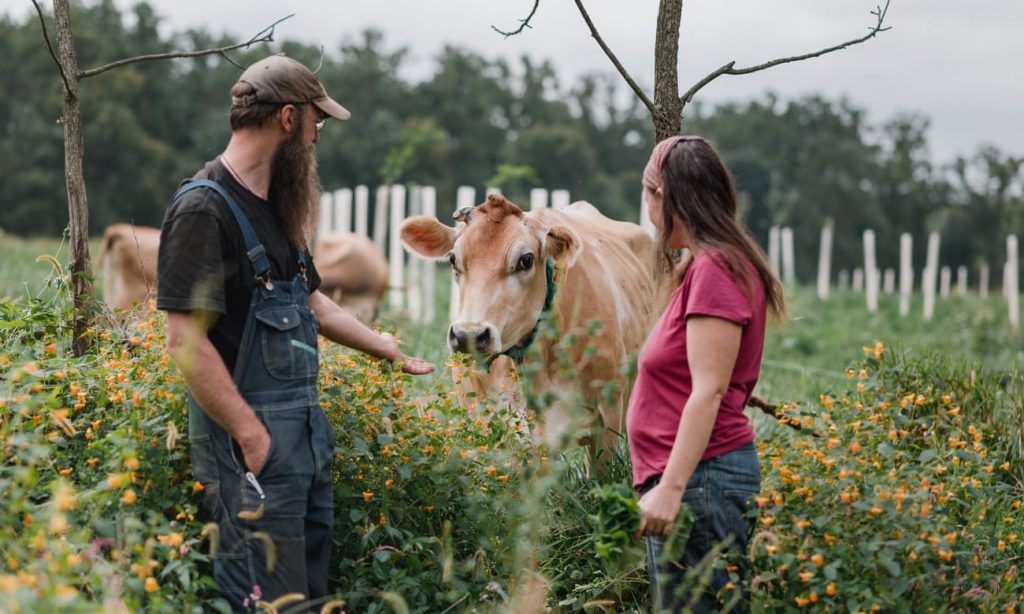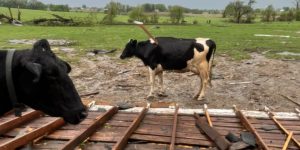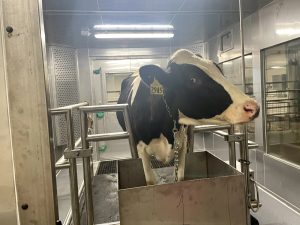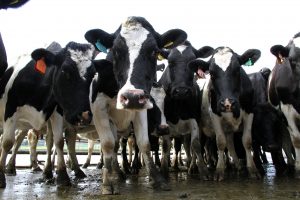
Frances Crowhill Sauder stands up to her knees in clover and jewelweed, gazing down at the nameless spring that originates up the wooded hillside from her 55-acre Fiddle Creek Dairy farm in Quarryville, Pennsylvania, which produces yoghurt and cheese from a small herd of grass-fed Jersey cows.
The spring’s lower banks border the farm’s pastures; they were recently planted with 450 young paw paw, persimmon, and other crop-bearing trees which, when harvested, will bring extra income to this small family operation that Crowhill Sauders and her husband, Tim, run against precariously slim profit margins.
The trees shimmer with insect visitors: praying mantids, small butterflies, bumblebees. In a field just behind this riparian buffer is another, slightly older, planting of 2,000 trees that plays host to tree swallows and bluebirds, and produces free forage for the cattle.
“With this kind of farm, we’re strapped for money all the time,” says Frances. But as well as providing an additional source of income from these crop-bearing trees, “we also get a functioning, healthy ecosystem and [can] live in better relation with creation,” says Tim.
Riparian buffers are trees, shrubs and other vegetation densely planted beside creeks, streams, and rivers. They’ve been used for decades on rangelands such as the Crowhill Sauders’s to restore waterways. They do this by preventing erosion, filtering out nitrogen and phosphorus from manure, cooling and feeding water-bound ecosystems. But their benefits go beyond detoxifying drinking water: they also mitigate floods and wildfires, improve fish and wildlife habitat, and sequester carbon – an important tool in reducing greenhouse gas emissions.
Farmers’ distrust a barrier
Conservation managers across the US would like to increase the number of riparian buffers on livestock farms. But to succeed, they need to incentivise cash-strapped farmers who may not realise that various grants exist to pay for them, and who may be sceptical of their usefulness. The Crowhill Sauders, for example, at first only agreed to their buffer because it provided a route to installing a much-needed culvert to keep the spring from flooding their property.
Over on the west coast, researchers are looking into riparian buffers’ potential to yield farmer income from carbon credits. For small east coast farmers, multi-function buffers such as those the Crowhill Sauders have embraced represent a hopeful way forward.
Some states, such as Minnesota, have legislatively mandated buffers of up to 50ft along lakes, rivers, and streams; in others, buffers are merely encouraged. Frances says she thinks fear of government interference makes some farmers resistant to them. Another factor, according to Lamonte Garber, watershed restoration coordinator for the Stroud Water Research Center in Avondale, PA, is management: “Farmers have to figure out how to pay for practices that might complicate their operation,” such as erecting fencing to keep cattle out of the water, and planting trees and shrubs that usurp land from pasture.
The Crowhill Sauders already had a fence – their farm’s previous owners used it to keep cattle in the water on hot days. And they weren’t sure why they needed more trees along their already verdant streambank. But consultant Austin Unruh of Crow & Berry Land Management in Lancaster County explained that the new plantings would fill in critical gaps. And the Crowhill Sauders could choose any fruit- and nut-bearing trees and shrubs they wanted. Harvestable buffers are a niche interest, but research shows them to be potentially profitable.
Carbon credits for tree-planting
In ocean-adjacent Marin and Sonoma counties, part of the largest dairy state, California, riparian buffers have long been adopted by ranchers and dairy farmers to improve water quality – 70% of the state’s drinking water runs through rangeland. Riparian buffers can cool streams and otherwise improve habitat for the region’s endangered and threatened coho salmon and steelhead trout, as well as mitigate wildfires, which have been raging out of control in the state for months.
Sonoma and Marin county dairy farmers, averaging around 700 acres and 300-plus head of cattle, tend toward organic grazing practices (unlike much larger confined feeding operations inland in the Central Valley). David Lewis, director of the University of California Cooperative Extension Marin County, points out that riparian buffers make pastures more efficient in these lands, because managing them requires farmers to figure out how to distribute cattle more uniformly, which improves grasses and soils.
He says that’s one way to incentivise farmers to adopt measures that could result in an additional 5,400 acres of riparian restoration here: “Anything that can reduce off-farm feed purchases, which eats into the bottom line, is a win.”
Another way might be through carbon credits. California counties are required to meet state greenhouse gas emission reduction targets. “People are looking at ways to connect the dots on what can happen on farms, and build momentum to carry out more riparian restoration,” says Lewis.
California’s Department of Conservation is currently developing a “creek calculator” to “figure out how much carbon results from stream restoration,” says Lewis. Dairy cooperative Organic Valley recently launched a pilot program with two of its farmers – funded with private, state, and federal money – to get a baseline understanding of “what practices sequester carbon that are appropriate for our membership”, according to the company’s director of sustainability, Nicole Rakobitsch.
Although there’s a lot of hype and no formal market for farm-generated carbon credits yet, Rajat Panwar, a business sustainability professor at Appalachian State University in Boone, North Carolina, expects it to quickly emerge as companies start to act on their carbon-neutral pledges. “If there ever gets to be a way to be paid for carbon credits that isn’t more trouble than it’s worth we will be interested,” says Tim Crowhill Sauders.

























